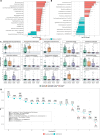Nanopore full length 16S rRNA gene sequencing increases species resolution in bacterial biomarker discovery
- PMID: 40691262
- PMCID: PMC12280133
- DOI: 10.1038/s41598-025-10999-8
Nanopore full length 16S rRNA gene sequencing increases species resolution in bacterial biomarker discovery
Abstract
Discovery of disease-related bacterial biomarkers could be a useful approach for early prevention or diagnosis of various afflictions, such as colorectal cancer. This typically involves analyzing small regions of the 16S rRNA gene (e.g. V3V4) through short-read technologies like Illumina, obtaining genus-level results. However, recent developments in third-generation sequencing, such as Oxford Nanopore Technologies (ONT)'s new R10.4.1 chemistry and its improved basecalling models, are beginning to allow for a more complete and accessible species-level analysis through full-length 16S rRNA gene sequencing (spanning regions V1-V9). Thus, the goal of this study was to compare and evaluate both approaches, using colorectal cancer biomarker discovery as a representative case. This was achieved through the analysis of feces from 123 subjects, comparing both methods (Illumina-V3V4 with DADA2 and QIIME2 vs. ONT-V1V9 with Emu), multiple Dorado basecalling models (fast, hac and sup) and multiple databases (SILVA vs. Emu's Default database). Basecalling models broadly resulted in similar taxonomic output, but had significantly higher observed species and different taxonomic identification the lower the basecalling quality (p-value<0.05). Database choice with Emu influenced the identified species greatly, with Emu's Default database obtaining significantly higher diversity and identified species than SILVA (p-value<0.05). However, it overconfidently classified at times what should be an unknown species as the closest match due to its database structure. Bacterial abundance between Illumina-V3V4 and ONT-V1V9 at the genus level correlated well (R2≥0.8). Nanopore sequencing identified more specific bacterial biomarkers for colorectal cancer than those obtained with Illumina, such as Parvimonas micra, Fusobacterium nucleatum, Peptostreptococcus stomatis, Peptostreptococcus anaerobius, Gemella morbillorum, Clostridium perfringens, Bacteroides fragilis and Sutterella wadsworthensis. Prediction of colorectal cancer through manual feature selection and machine learning resulted in an AUC of 0.87 with 14 species or 0.82 with just 4 species (P. micra, F. nucleatum, B. fragilis and Agathobaculum butyriciproducens). Full 16S rRNA V1V9 sequencing through Oxford Nanopore and its new R10.4.1 chemistry achieved accurate species-level bacterial identification, facilitating the discovery of more precise disease-related biomarkers and increasing the taxonomic fidelity of future microbiome analyses.
Keywords: 16S rRNA; Biomarkers; Colorectal cancer; Gut microbiome; Illumina; Metabarcoding; Oxford Nanopore; V1V9.
© 2025. The Author(s).
Conflict of interest statement
Declarations. Competing interests: All the authors declare no competing interests. Ethics approval and consent to participate: This study adhered to the standards of clinical practice and research regulations (Law of Biomedical Research 14/2007), in agreement with the Declaration of Helsinki and the Convention on Human Rights and Biomedicine. Compliance with the protection of non-public personal data of all those involved within the RGPD – UE 2016/679, LOPDGDD 3/2018 Law 41/2002 and its implementing regulations, Royal Decree 1720/2007, were enforced. This project (PI20/00413), granted by Carlos III Health Institute (ISCIII; Spain), was supervised by the local ethics committee, the Research Ethical Committee of Galicia (code CEIm-G 2018/609, Galicia, Spain), and by the Spanish Agency for Medicines and Healthcare Products (AEMPS) for the use of CRC patients’ samples from CHUAC (A Coruña, Galicia, Spain). The experimental protocols were aproved by the Ethical Committee of Galicia (CEIm-G 2018/609, Galicia, Spain). Informed consent for Biobank (CHUAC, A Coruña, Galicia, Spain, UNE-EN ISO 9001-2015) was signed by all individuals grouped in this study. Anonymized clinical data used during the study for CRC patients was obtained from the Galician Health Service (SERGAS). All individuals recruited in this project (cancer patients and controls) signed a formal consent form for the publication of scientific and clinical results in scientific articles.
Figures




Similar articles
-
Comparison of Illumina and Oxford Nanopore Technology systems for the genomic characterization of Streptococcus pneumoniae.Microbiol Spectr. 2025 Jul;13(7):e0129424. doi: 10.1128/spectrum.01294-24. Epub 2025 May 28. Microbiol Spectr. 2025. PMID: 40434130 Free PMC article.
-
Accurate and reproducible whole-genome genotyping for bacterial genomic surveillance with Nanopore sequencing data.J Clin Microbiol. 2025 Jul 9;63(7):e0036925. doi: 10.1128/jcm.00369-25. Epub 2025 Jun 13. J Clin Microbiol. 2025. PMID: 40511924 Free PMC article.
-
Evaluation of V3-V4 and FL-16S rRNA amplicon sequencing approach for microbiota community analysis of tracheostomy aspirates.mSphere. 2025 Jul 22:e0038825. doi: 10.1128/msphere.00388-25. Online ahead of print. mSphere. 2025. PMID: 40693760
-
Cost-effectiveness of using prognostic information to select women with breast cancer for adjuvant systemic therapy.Health Technol Assess. 2006 Sep;10(34):iii-iv, ix-xi, 1-204. doi: 10.3310/hta10340. Health Technol Assess. 2006. PMID: 16959170
-
A rapid and systematic review of the clinical effectiveness and cost-effectiveness of topotecan for ovarian cancer.Health Technol Assess. 2001;5(28):1-110. doi: 10.3310/hta5280. Health Technol Assess. 2001. PMID: 11701100
References
-
- Austin, B. The value of cultures to modern microbiology. Antonie Van Leeuwenhoek110(10), 1247–1256 (2017). - PubMed
MeSH terms
Substances
Grants and funding
- PRTR-C17.I1/Spanish Ministry of Science and Innovation-Autonomous Community of Galicia
- RTI2018-102032-B-I00/Spanish Ministry of Science and Innovation
- CB21/13/00055/CIBERINFEC, Instituto de Salud Carlos III (ISCIII)
- IN607A2024/09/Xunta de Galicia (Spain)
- PI20/00413/Instituto de Salud Carlos III (ISCIII)
LinkOut - more resources
Full Text Sources
Medical

